Introduction: Navigating the World of Inbound Leads
Inbound Lead Generation: An Overview
Inbound leads are a crucial part of the inbound marketing process and any lead generation process.
These are individuals or businesses that find your company through channels like search engines, blogs, or social media. Unlike outbound leads, you don't reach out to inbound leads; they come to you.
The inbound lead generation strategy involves creating content and experiences that attract these potential customers. The goal is not just to increase website visitors but to convert these visitors into sales-qualified leads.
Inbound Leads vs. Outbound Leads: Why It Matters

Understanding the difference between inbound and outbound leads is essential for your sales team and lead generation strategies. Inbound leads usually offer a higher ROI and align more closely with your target audience. They've engaged with your relevant content or marketing-qualified leads, making them more likely to convert.
On the other hand, outbound leads require more effort from your own sales reps and marketing teams. These are individuals you reach out to, and they may not be aware of your products or services, making the sales process more challenging.
Choosing between inbound and outbound lead generation methods depends on various factors, including your business model and target audience. However, inbound leads often provide a more cost-effective and efficient lead generation process.
By focusing on inbound lead generation techniques, you can create valuable content that can improve the quality of your leads and, ultimately, your sales funnel.
Understanding Inbound and Outbound Leads
What are Inbound Leads?
Inbound leads are potential customers who come to you, often due to your inbound marketing efforts. They find you through search engines, social media, or other online channels. These leads are valuable because they're already interested in your products or services, making them more likely to convert into paying customers.
What are Outbound Leads?
Outbound leads are the opposite. These are individuals or businesses you reach out to via cold calls, emails, or direct advertising. While outbound lead generation can be effective, it often requires more resources and has a lower ROI than inbound leads.
Key Differences and Similarities

Purpose
Inbound leads generally align more with your business goals, as they've sought you out. On the other hand, outbound leads may not even be aware of your business before you contact them.
ROI (Return on Investment)
When it comes to ROI, inbound leads are a game-changer.
According to HubSpot, inbound marketing strategies, on average, cost 62% less per lead than traditional outbound methods. This makes the ROI for inbound leads significantly higher.
Your sales team can also focus more on generating leads and closing deals than chasing potential customers, boosting ROI.
Market Understanding
Understanding your target audience is crucial in both inbound lead capture and outbound strategies. However, with inbound leads, you often get more valuable data.
For instance, Google Analytics can show you exactly what search terms brought visitors to the landing page on your site, allowing you to refine your inbound lead generation strategies.
Speed and Timing
While outbound leads can be quicker to to generate leads, the conversion rate is often lower. According to a study by Marketing Sherpa, the average conversion rate for outbound leads is 1.7%, compared to 14.6% for inbound leads.
This means your sales team can move inbound leads through the sales funnel more efficiently.
Quality of Leads
The quality of inbound leads is generally higher.
According to Gartner, businesses that prioritize inbound marketing are 13 times more likely to achieve a positive ROI on their efforts.
High-quality leads are more likely to turn into paying customers, affecting your bottom line positively.
Cost and Investment
Inbound leads are generally more cost-effective.
A report by Demand Metric indicated that content marketing, a key inbound lead generation technique, costs 62% less than traditional marketing and generates about three times as many leads.
More differences between outbound and inbound leads
Understanding the nuances between inbound and outbound leads is crucial for any effective sales qualified lead- generation strategy. Here are 15 key differences:
- Source of Lead:
- Inbound Leads: Generated through content marketing, SEO, and social media platforms.
- Outbound Leads: Generated through cold calling, paid advertising, and direct mail.
- Cost and Investment:
- Inbound: Generally lower cost per acquisition.
- Outbound: Higher initial investment, especially in advertising.
- Sales Process:
- Inbound: Longer sales cycles, nurturing required.
- Outbound: Shorter sales cycles, often immediate.
- Level of Awareness:
- Inbound: High, as they've likely consumed your content.
- Outbound: Low, often unaware of your brand.
- Quality of Leads:
- Inbound: Often, higher-quality leads more likely to convert.
- Outbound: Varying quality, may require more effort to qualify.
- Target Audience:
- Inbound: Self-selected, already interested in your niche.
- Outbound: You select them, may not be interested.
- ROI (Return on Investment):
- Inbound: Higher ROI, according to HubSpot, 3x more leads per dollar spent.
- Outbound: Lower ROI, more expensive to maintain.
- Trust and Credibility:
- Inbound: Higher, due to educational content.
- Outbound: Lower, due to unsolicited contact.
- Timing:
- Inbound: Leads come in over time.
- Outbound: Timing is controlled by the sales team.
- Control Over the Process:
- Inbound: Less control, dependent on user actions.
- Outbound: More control, proactive outreach.
- Lead Generation Process:
- Inbound: Organic, long-term.
- Outbound: Forced, short-term.
- Search Engine Optimization:
- Inbound: Heavily reliant.
- Outbound: Not reliant.
- Sales Team Involvement:
- Inbound: Less initial involvement, more on nurturing.
- Outbound: Heavily involved from the start.
- Social Media Involvement:
- Inbound: High, often a primary channel.
- Outbound: Low, not commonly used for lead gen.
- Data-Driven:
- Inbound: Metrics like website visitors and engagement rates are crucial.
- Outbound: Focuses on metrics like call rates and conversion percentages.
By understanding these differences, you can tailor your online lead generation strategies to be more effective, whether focusing on inbound or outbound methods. Want to know more ? Click here
Inbound Lead Advantages
Timing and Inbound Leads
When it comes to lead generation, timing is everything.
Unlike outbound leads, inbound leads often come to you when they're already interested in your product or service. This is a crucial advantage because not all inbound leads make the sales process.
According to data from HubSpot, 74% of companies say converting leads into customers is their top priority. With inbound leads, the timing is already optimized, making the conversion process smoother and more efficient.
Awareness Through Inbound Marketing
Inbound, marketing strategy plays a vital role in creating awareness and attracting high-quality leads.
Utilizing strategies like content marketing, search engine optimization, and social media platforms, you can educate potential customers and build trust.
This is not just about generating traffic; it's about attracting the right kind of traffic—your target audience. Studies show that inbound marketing to target audiences costs 62% less per lead than traditional outbound methods.
Trust and Credibility in Inbound Lead Generation
Inbound lead generation techniques, such as offering valuable content through blogs or webinars, help establish your brand as a credible resource.
According to DemandGen, 47% of buyers view three to five pieces of content before engaging with a sales or customer service representative rep.
By providing valuable insights, you're not just building trust with existing customers; you're also nurturing sales qualified leads that are more likely to convert.
Inbound Lead Generation Strategies
Inbound Lead Generation Process
Inbound leads are crucial for business growth. The inbound lead generation process focuses on attracting potential customers who have shown interest in your product or service. According to HubSpot, inbound leads cost 61% less than outbound leads, making it a cost-effective strategy.
Types of Inbound Lead Generation Strategies
Content Marketing
Content marketing is a key inbound lead generation strategy. It involves creating relevant content to attract website visitors.
According to the Content Marketing Institute, content marketing produces three times more leads per dollar spent compared to traditional marketing methods.
It's not just about creating content; it's about creating valuable content that solves problems for your target audience.
This increases your website's search engine rankings and attracts more qualified leads.
Search Engine Optimization

Search engine optimization (SEO) is essential for increasing your online visibility. According to data from BrightEdge, 68% of online experiences start with a search engine.
Effective SEO helps your website rank higher in search results, increasing the likelihood that potential customers will find you. It involves optimizing website content, improving page load speed, and building high-quality backlinks, among other techniques.
Social Media Marketing

Social media marketing is another effective strategy for generating inbound leads. According to Sprout Social, social media generates twice the leads of traditional outbound methods.
Platforms like Facebook and LinkedIn allow you to target ads based on user behavior and demographics, ensuring that your message reaches your target audience.

Email Marketing

Email marketing remains a powerful tool for inbound lead generation. According to Campaign Monitor, every dollar spent on email marketing has an ROI of $44. It's not just about sending emails but about sending the right content to the right people at the right time. Segmentation and personalization are key here.
The sales team and marketing team should collaborate to make the most of these inbound lead-generation strategies. The sales team's insights into customer needs can guide the marketing team in creating more targeted and effective content.
By effectively employing these inbound lead generation strategies, you're increasing leads and making the sales process more efficient. This is backed by data showing that companies excelling at lead nurturing generate 50% more sales-ready leads at a 33% lower cost (Forrester Research).
Outbound Lead Generation
Definition of Outbound Lead Generation
Outbound lead generation is a strategy where the sales team actively initiates contact with prospective leads, contrasting with inbound lead generation, where businesses rely on attracting website visitors. In outbound lead generation, the focus is on direct methods like cold calling, email marketing, and paid advertising to generate sales-qualified leads.
Outbound Lead Generation Methods
Cold Calling: A tried-and-true method where the sales team directly engages with potential customers. While traditional, it remains an effective part of a comprehensive lead generation strategy.

Email Marketing: This involves sending targeted emails to a curated list of potential customers, aiming to convert them into sales-qualified leads. It's a key component of any outbound lead generation process.
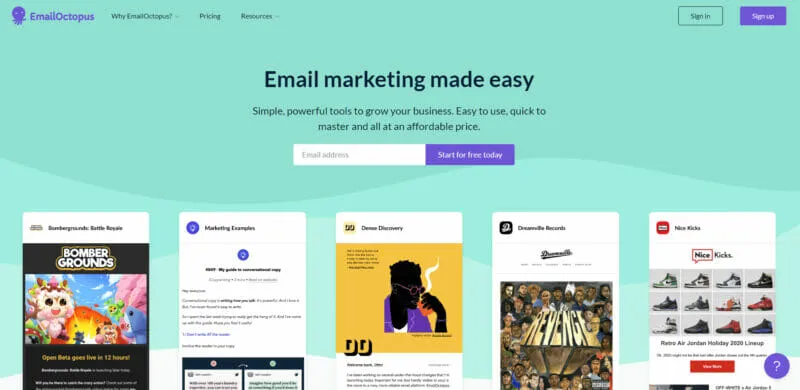
Paid Advertising: Utilizing platforms like Google Ads, you can position your services or products in front of a target audience, enhancing your lead generation campaign.

Trade Shows: Though considered old-school, trade shows offer invaluable face-to-face interactions that digital methods can't fully replicate, contributing to a diversified lead generation strategy.

Social Media Advertising: Platforms like Facebook and Instagram allow for precise targeting of specific demographics, making them valuable tools in your outbound lead generation techniques.
Benefits and Challenges of Outbound Lead Generation
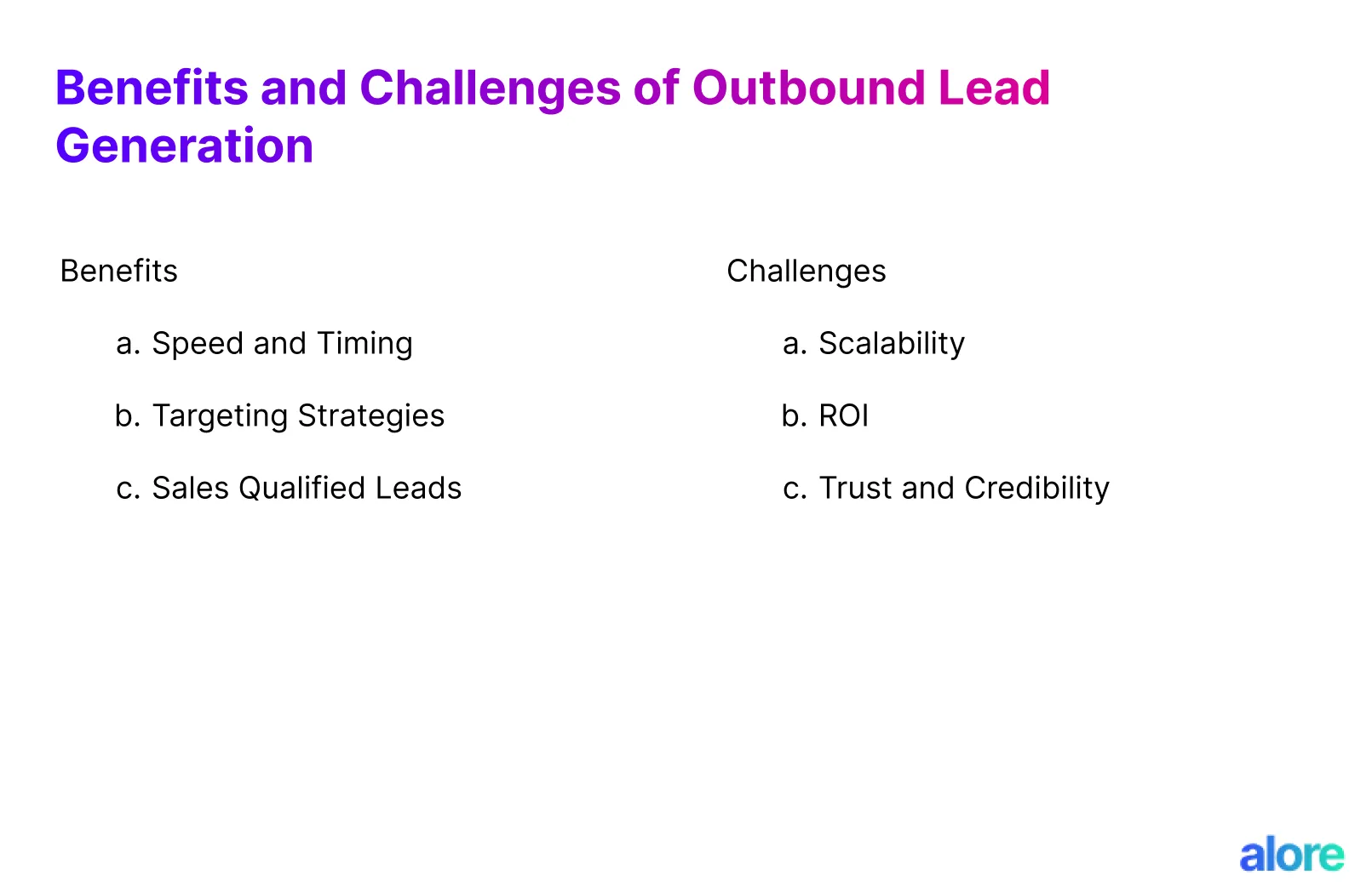
Benefits
- Speed and Timing: In outbound lead generation, your sales team controls when and whom to reach out to, accelerating the lead generation process.
- Targeting Strategies: Outbound lead generation allows you to tailor your message to fit your target audience's specific needs and pain points, making your marketing strategy more focused.
- Sales Qualified Leads: With a well-curated list, the sales qualified leads you generate are often ready for the sales pitch, enhancing the quality of leads.
Challenges
- Scalability: Cold calling and other outbound lead generation techniques require consistent quality and intensity, which can be difficult to maintain as you scale your sales team.
- ROI (Return on Investment): The ROI can be lower in outbound lead generation if not executed correctly, affecting your lead generation strategy.
- Trust and Credibility: It's often more challenging to build trust when you're the one initiating contact, which can affect the sales process.
Data-Driven Insight: According to a 2020 study, outbound leads cost 39% more than inbound leads. However, the closing rate for outbound leads can be higher if the sales team employs effective targeting strategies.
Actionable Advice: If you're struggling with low ROI, consider revising your outbound lead generation strategies. A/B testing can offer valuable insights into what's working and not, helping you generate leads more effectively.
Inbound Lead Generation in 2024
Effective Inbound Lead Generation Techniques
The inbound lead generation process in 2024 will be more data-driven than ever. Search engine optimization (SEO) remains crucial, with 53% of website traffic originating from organic search.
But it's not just about attracting website visitors; it's about converting them into qualified leads. Techniques like lead capture forms can increase conversion rates by up to 25%, making them an essential part of your inbound lead generation strategy.
Social Media Platforms for Inbound Leads
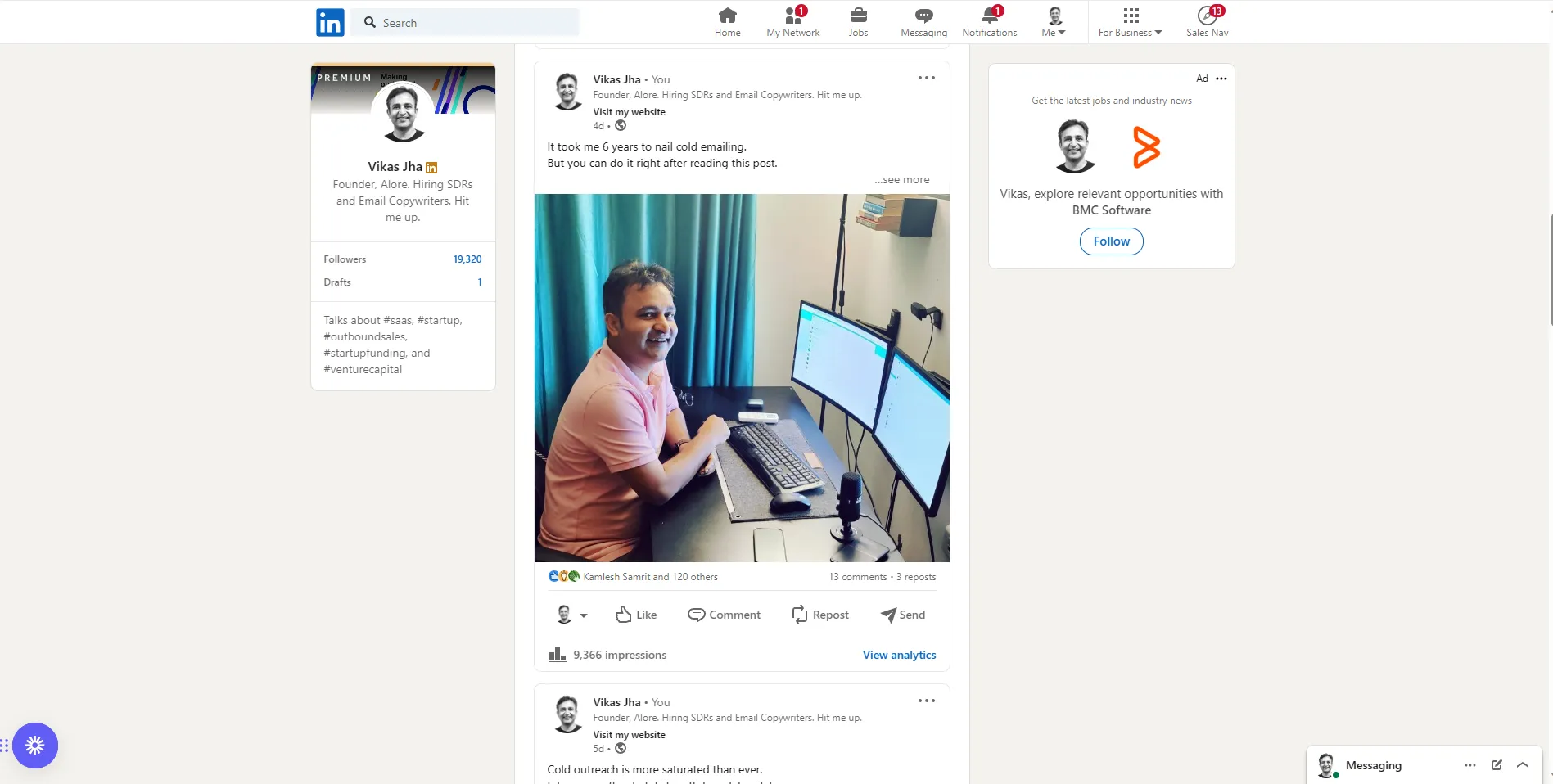
Social media isn't just for sharing memes; it's a serious tool for generating inbound leads.
With 45% of the global population on social media, platforms like Facebook and LinkedIn are invaluable for targeting specific demographics.
The key is to create valuable content that resonates with your target audience, encouraging them to become potential customers.
Paid Advertising and Retargeting in Inbound Lead Generation

Paid advertising plays a dual role in both outbound and inbound lead generation. Specifically, retargeting can boost conversion rates by 150%.
This strategy is not just about encouraging visitors to return; it's about leveraging data to make your ads more effective. By 2024, global digital ad spending will reach $517 billion, indicating a shift towards more sophisticated advertising techniques.
Why These Channels Will Work More in 2024
Why focus on these channels in 2024?
The answer lies in the numbers.
Digital ad spending is rising, and it is expected to hit $517 billion by 2024.
Additionally, AI and machine learning advancements will make targeting more precise, ensuring a better ROI for your marketing efforts.
Choosing the Right Lead Generation Strategy
Inbound vs. Outbound: Which is Best for Your Sales Team?
As a sales team, your primary goal is to close deals and generate revenue. But to do that, you need leads—lots of them. The question is, should you focus on inbound or outbound methods to fill your pipeline? According to HubSpot, inbound leads can cost 61% less than outbound leads. That's a significant saving but not the only factor to consider.
Why Sales Teams Might Prefer Inbound:
- Budget-Friendly: If your product is priced at a lower point—say, $10 a month—inbound channels like SEO and content marketing can be a godsend. You need volume to scale, and inbound methods can attract a large audience at a lower cost per lead.
- Quality of Leads: Inbound leads are often more educated about your product or service, having found you through their research. This can make the sales process smoother and more efficient.
- Sustainability: Once your inbound channels are set up, they can generate leads with minimal ongoing effort, freeing you to focus on closing deals.
Why Sales Teams Might Lean Toward Outbound:
- Precision Targeting: Outbound methods allow you to go after the type of customer you want. This can be especially useful if you're in a niche industry or selling a high-ticket item.
- Speed: If you need to hit your quarterly targets and time is of the essence, outbound methods like cold calling can generate leads faster than inbound methods.
- Control: With outbound, you decide when to call or send the email, giving you more control over your daily activities and lead flow.
Action Steps for Sales Teams:
- Collaborate with Marketing: Your marketing colleagues can provide insights into which inbound methods have been most effective, helping you decide where to focus your efforts.
- Review Historical Data: Look at your CRM to identify which methods have historically brought in the most sales-qualified leads.
- Pilot Programs: Consider running short-term tests of each method to compare the quality and quantity of leads generated.
How do you decide which lead generation process to use? (A Step-by-Step Guide with Explanation)
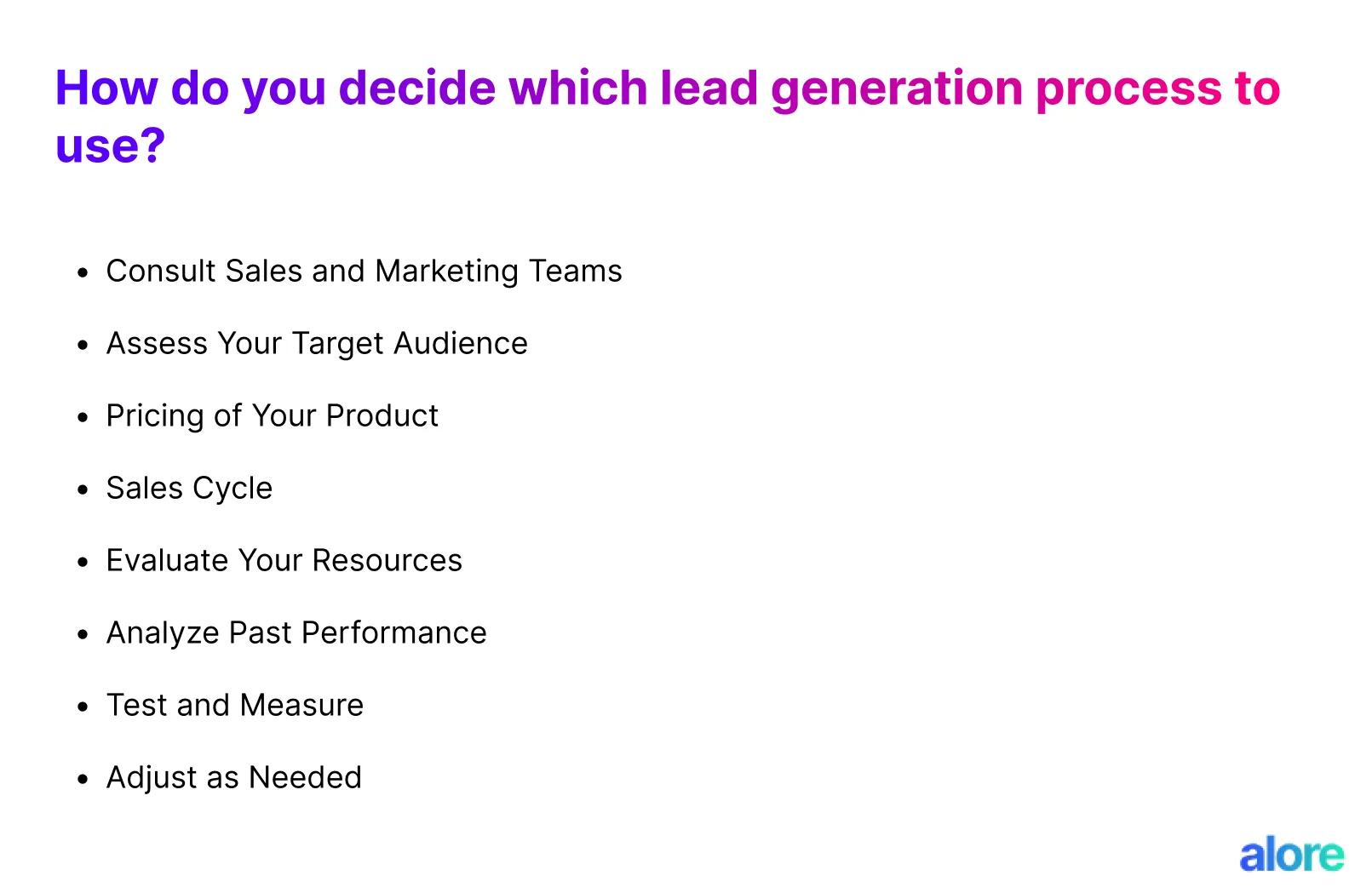
- Consult Sales and Marketing Teams: Start by talking to the people on the ground. Your sales reps and marketing teams have firsthand experience and can provide insights into the most effective methods.
- Assess Your Target Audience: Knowing who you're trying to reach is crucial. Are they more active on social media platforms, or are they likely to respond to a targeted email? Content Marketing Institute data shows that 91% of B2B marketers use content marketing, indicating a strong preference for inbound methods.
- Pricing of Your Product: If your product is priced at a lower point, like $10 a month, inbound channels such as SEO can be more effective. You need volume to scale; reaching a large audience through outbound methods like cold calling is less feasible.
- Sales Cycle: Consider the length of your sales cycle. Shorter cycles may benefit more from inbound methods, where the customer quickly moves from awareness to decision. Longer cycles might require the nurturing that outbound methods can offer.
- Evaluate Your Resources: Do you have a content team for inbound marketing or a sales team skilled in cold calling? InsideSales.com states it takes 18 calls to connect with a buyer using outbound methods.
- Analyze Past Performance: Use your CRM to see where your qualified leads generally come from. If your website visitors convert at a rate of 5%, that's a strong indicator for inbound.
- Test and Measure: Implement A/B tests to measure the effectiveness of your strategies. Metrics like cost-per-lead and lead-to-customer ratio can offer valuable insights.
- Adjust as Needed: Market conditions and consumer behaviors aren't static. Be prepared to pivot your strategies accordingly. For instance, it's time to reassess if your social media engagement drops by 20%.
Final Thoughts: The Strategic Approach to Lead Generation for Sales Teams
Navigating the complexities of lead generation is critical for any sales team. According to HubSpot, inbound leads can cost 61% less than outbound leads, a data point that can't be ignored when budgeting.
- Inbound vs. Outbound: Your sales team needs to consider the cost and scalability of each approach. For instance, if your product is priced at $10 a month, inbound methods like SEO can help you reach the volume of leads you'll need to make that pricing model work. On the other hand, outbound methods may not scale as efficiently for such a high volume.
- Lead Generation Techniques: The choice of techniques also depends on your sales cycle. A longer sales cycle might benefit more from outbound methods that allow for a deeper relationship-building process. Data shows a 20% increase in lead quality when outbound methods are tailored for longer sales cycles.
- Decision-making Process: We've provided a step-by-step guide to evaluate which lead-generation process aligns with your sales team's goals and skills. Key performance indicators like Customer Lifetime Value (CLV) and Customer Acquisition Cost (CAC) should guide your decision.
- Sales Team's Role: The skills within your sales team can significantly influence the effectiveness of your chosen lead generation strategy. If your team excels in content creation, an inbound lead generation strategy could be more effective.
- Future Trends: Data suggests that by 2024, social media and retargeting will become even more effective in inbound lead generation. This is crucial for sales teams to understand as they plan for the future.
The bottom line is that your lead generation strategy needs to align with multiple factors: your product's pricing, your sales cycle length, and your team's strengths. It's not just about what methods to use, but why they are the most effective for your specific situation and how to implement them for maximum ROI.
By making data-backed, well-informed decisions, your sales team is better positioned to build a pipeline that fills quickly and fills with high-quality, sales-ready leads.
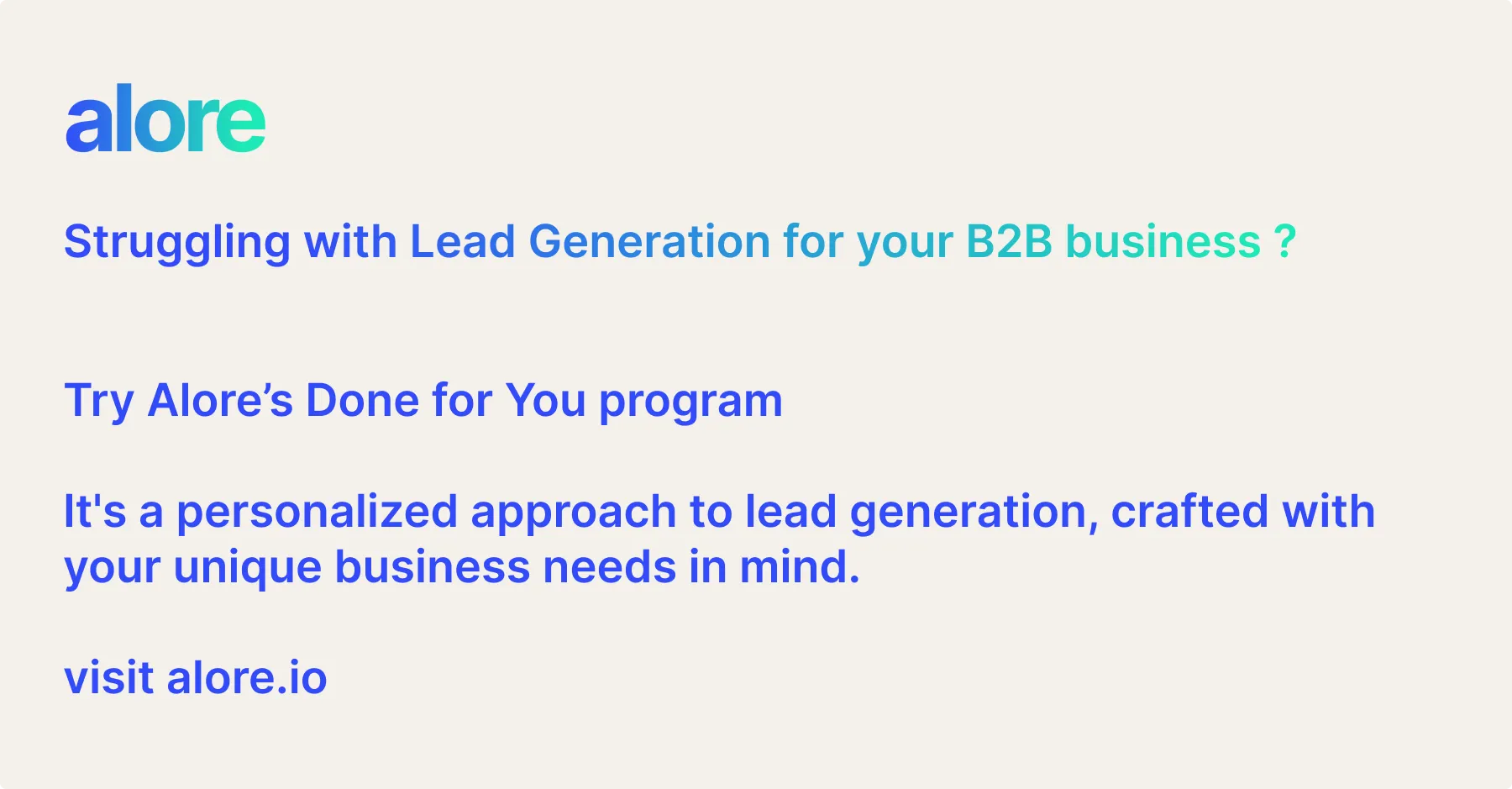

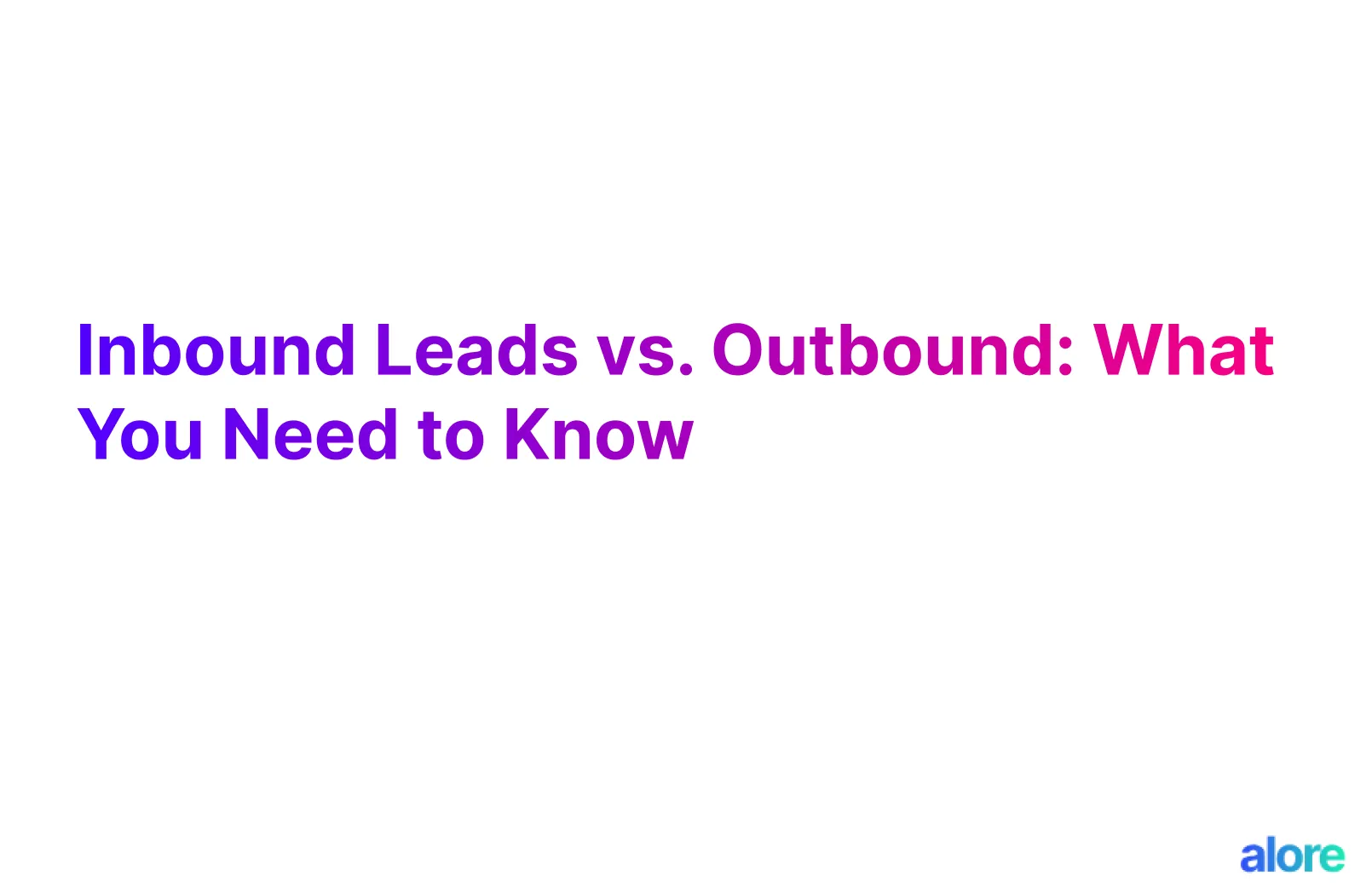



.jpg)

.jpg)
